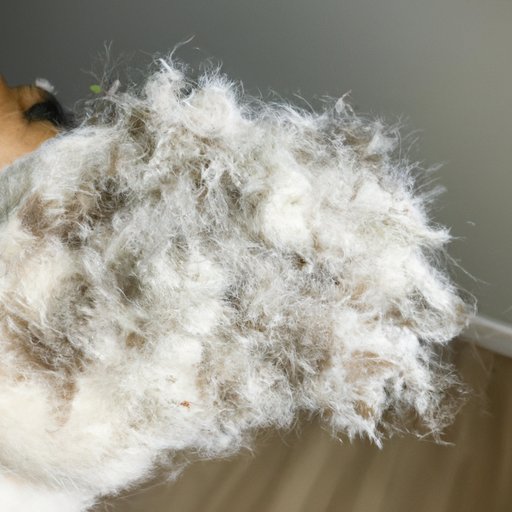Introduction
Dogs are often referred to as man’s best friend, but one of the biggest challenges of owning a furry companion is dealing with all the hair they shed. Pet owners must contend with fur on furniture, carpets, and clothing, not to mention the daily task of vacuuming up the piles of hair that accumulate around the house. But not all dogs shed the same amount – some breeds are more prone to shedding than others.
In this article, we explore what dog sheds the most, examine the pros and cons of high-shedding breeds, and provide practical strategies for minimizing shedding in your home. We also discuss the different grooming practices needed to keep high-shedding dogs looking and feeling their best.
Comparing Popular Dog Breeds: Which Ones Shed the Most?
When it comes to shedding, certain breeds are more prone to it than others. Large dogs such as Labrador Retrievers, German Shepherds, and Golden Retrievers are known for their heavy coats and shedding tendencies. Other breeds such as Poodles, Bichon Frises, and Shih Tzus have coats that require regular brushing and grooming to prevent matting and tangling.
On the other end of the spectrum, there are also many low-shedding breeds such as Maltese, Yorkies, and Bolognese, which shed very little and have minimal grooming requirements. These types of dogs are ideal for pet owners who want to avoid the hassle of dealing with excessive shedding.
A Guide to Understanding Dog Shedding Habits
In order to understand why some dogs shed more than others, it’s important to look at the underlying causes of excessive shedding. Dogs naturally shed their coats as part of their natural life cycle, but some dogs shed more than normal due to a variety of factors.
One of the main reasons for excessive shedding is improper nutrition. Dogs need a balanced diet that includes essential vitamins and minerals to maintain healthy skin and coat. Lack of proper nutrition can lead to dry, brittle hair that falls out more easily.
Environmental factors such as temperature and humidity can also cause excessive shedding. Dogs with thick coats may shed more during the summer months when the weather is hot and humid, while those with thin coats may shed more during the winter when the air is drier.
Finally, some dogs may be genetically predisposed to shedding more than others. Dogs with double coats, such as huskies, shepherds, and collies, tend to shed more than single-coated breeds.

How to Minimize Dog Shedding in Your Home
The best way to reduce shedding in your home is to start by choosing a low-shedding breed. These breeds are a good choice for pet owners who want to minimize the amount of cleaning and vacuuming required to keep their home fur-free. However, even low-shedding breeds will still shed some hair, so it’s important to implement regular grooming practices to keep the shedding to a minimum.
Regular brushing is essential for keeping shedding under control. Brushing your dog’s coat helps to remove loose hairs before they have a chance to fall onto furniture and clothing. Additionally, bathing your dog regularly (every two to four weeks) can help to reduce shedding. Make sure you use a shampoo specifically designed for dogs as human shampoos can strip the natural oils from their coats.
Finally, make sure your dog is getting enough exercise. Regular exercise helps to promote a healthy coat, and it also gives your pup an outlet to release energy and stress, which can reduce shedding.
Investigating the Different Grooming Practices Needed for High-Shedding Dogs
If you have a high-shedding breed, you may need to adjust your grooming practices to accommodate their needs. High-shedding breeds require more frequent brushing than low-shedding breeds, as well as regular baths and haircuts. It’s important to invest in the right tools and supplies to ensure your pup is properly groomed. Look for a brush specifically designed for your breed, as well as a quality shampoo and conditioner.
It’s also important to stick to a regular grooming schedule. You should plan to brush your dog at least once a week, bathe them every two to four weeks, and have them professionally groomed every few months. This will help to keep their coat healthy and reduce shedding.
Conclusion
Dogs come in all shapes and sizes, and each one has unique shedding habits. While some breeds are more prone to excessive shedding than others, all pet owners can benefit from implementing regular grooming practices to keep their pup’s coat healthy and minimize the amount of fur in their home. Low-shedding breeds are a great option for pet owners who want to avoid the hassle of daily maintenance, but even these breeds require some upkeep to keep their coats looking and feeling their best.
By following the tips outlined in this article, you’ll be well on your way to finding the perfect pup for your lifestyle, regardless of their shedding habits. With the right knowledge and care, managing your pup’s shedding doesn’t have to be a chore.


